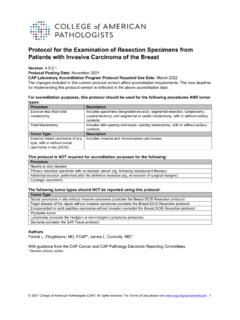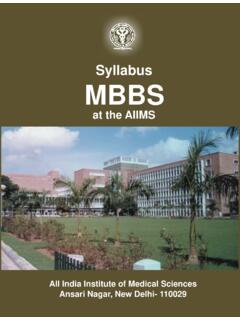Transcription of Protocol for the Examination of Cystectomy Specimens From ...
1 2021 College of American Pathologists (CAP). All rights reserved. For Terms of Use please visit . 1 Protocol for the Examination of Cystectomy Specimens From Patients With Carcinoma of the Urinary Bladder Version: Protocol Posting Date: June 2021 CAP Laboratory Accreditation Program Protocol Required Use Date: March 2022 The changes included in this current Protocol version affect accreditation requirements. The new deadline for implementing this Protocol version is reflected in the above accreditation date. For accreditation purposes, this Protocol should be used for the following procedures AND tumor types.
2 Procedure Description Cystectomy Includes Specimens designated partial, total or radical Cystectomy , radical cystoprostatectomy (for bladder cancer), and anterior exenterations Tumor Type Description Carcinomas Includes invasive carcinomas of the urinary tract, including urothelial carcinoma, its morphological variants, and other carcinoma (squamous cell carcinoma, adenocarcinoma, M llerian carcinoma, neuroendocrine carcinoma, and sarcomatoid carcinoma)# # This Protocol is recommended for reporting noninvasive urothelial tumors (papillary and flat), but it is not required for accreditation purposes.
3 This Protocol is NOT required for accreditation purposes for the following: Procedure Biopsy, transurethral resection of the bladder tumor# (TURBT), or enucleations (consider Urinary Bladder Biopsy Protocol ) Primary resection specimen with no residual cancer (eg, following neoadjuvant therapy) Cytologic Specimens # Transurethral resection of a bladder tumor is NOT considered to be the definitive resection specimen, even though the entire cancer may be removed. The following tumor types should NOT be reported using this Protocol : Tumor Type Urachal Carcinoma Lymphoma (consider the Hodgkin or non-Hodgkin Lymphoma protocols) Sarcoma (consider the Soft Tissue Protocol ) Authors Gladell P.
4 Paner, MD*; Ming Zhou, MD, PhD*; John R. Srigley, MD*; Lara R. Harik, MD; Mahul B. Amin, MD; Robert Allan, MD; Brett Delahunt, MD; Bernard H. Bochner, MD; Jonathan I. Epstein, MD; David J. Grignon, MD; Peter A. Humphrey, MD, PhD; Rodolfo Montironi, MD; Jason Pettus, MD; Victor E. Reuter, MD. With guidance from the CAP Cancer and CAP pathology Electronic Reporting Committees. * Denotes primary author. CAP Approved 2 Accreditation Requirements This Protocol can be utilized for a variety of procedures and tumor types for clinical care purposes. For accreditation purposes, only the definitive primary cancer resection specimen is required to have the core and conditional data elements reported in a synoptic format.
5 Core data elements are required in reports to adequately describe appropriate malignancies. For accreditation purposes, essential data elements must be reported in all instances, even if the response is not applicable or cannot be determined. Conditional data elements are only required to be reported if applicable as delineated in the Protocol . For instance, the total number of lymph nodes examined must be reported, but only if nodes are present in the specimen. Optional data elements are identified with + and although not required for CAP accreditation purposes, may be considered for reporting as determined by local practice standards.
6 The use of this Protocol is not required for recurrent tumors or for metastatic tumors that are resected at a different time than the primary tumor. Use of this Protocol is also not required for pathology reviews performed at a second institution (ie, secondary consultation, second opinion, or review of outside case at second institution). Synoptic Reporting All core and conditionally required data elements outlined on the surgical case summary from this cancer Protocol must be displayed in synoptic report format. Synoptic format is defined as: Data element: followed by its answer (response), outline format without the paired Data element: Response format is NOT considered synoptic.
7 The data element should be represented in the report as it is listed in the case summary. The response for any data element may be modified from those listed in the case summary, including Cannot be determined if appropriate. Each diagnostic parameter pair (Data element: Response) is listed on a separate line or in a tabular format to achieve visual separation. The following exceptions are allowed to be listed on one line: o Anatomic site or specimen, laterality, and procedure o Pathologic Stage Classification (pTNM) elements o Negative margins, as long as all negative margins are specifically enumerated where applicable The synoptic portion of the report can appear in the diagnosis section of the pathology report, at the end of the report or in a separate section, but all Data element.
8 Responses must be listed together in one location Organizations and pathologists may choose to list the required elements in any order, use additional methods in order to enhance or achieve visual separation, or add optional items within the synoptic report. The report may have required elements in a summary format elsewhere in the report IN ADDITION TO but not as replacement for the synoptic report ie, all required elements must be in the synoptic portion of the report in the format defined above. Summary of Changes v General Reformatting Revised Margins Section Revised Lymph Nodes Section Added Distant Metastasis Section Removed pTX and pNX Staging Classification Reformat Tumor Extent Section CAP Approved 3 Reporting Template Protocol Posting Date: June 2021 Select a single response unless otherwise indicated.
9 CASE SUMMARY: (URINARY BLADDER: Cystectomy , Anterior Exenteration) Standard(s): AJCC-UICC 8 This Protocol is recommended for reporting noninvasive urothelial tumors (papillary and flat), but it is not required for accreditation purposes. SPECIMEN (Note A) Procedure ___ Partial Cystectomy ___ Radical Cystectomy (total Cystectomy ) ___ Radical cystoprostatectomy ___ Anterior exenteration ___ Other (specify): _____ ___ Not specified TUMOR Tumor Site (select all that apply) ___ Trigone ___ Right lateral wall ___ Left lateral wall ___ Anterior wall ___ Posterior wall ___ Dome ___ Other (specify): _____ ___ Cannot be determined.
10 _____ Histologic Type (Note B) (select all that apply) Urothelial ___ Papillary urothelial carcinoma, noninvasive ___ Papillary urothelial carcinoma, invasive ___ Urothelial carcinoma in situ ___ Urothelial carcinoma, invasive ___ Urothelial carcinoma, nested (including large nested) variant ___ Urothelial carcinoma, microcystic variant ___ Urothelial carcinoma, micropapillary variant ___ Urothelial carcinoma, lymphoepithelioma-like variant ___ Urothelial carcinoma, plasmacytoid / signet ring cell / diffuse ___ Urothelial carcinoma, sarcomatoid variant ___ Urothelial carcinoma, giant cell variant ___ Urothelial carcinoma, poorly differentiated variant ___ Urothelial carcinoma, lipid-rich variant ___ Urothelial carcinoma.















